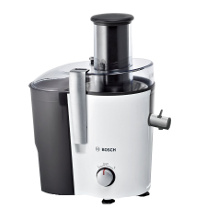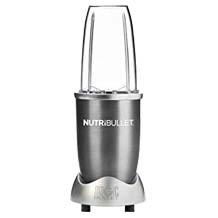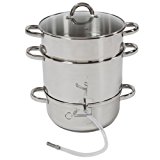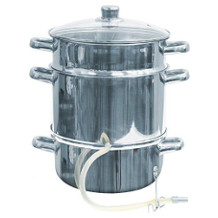Steam juicer purchasing advice: how to choose the right product
- The most important things in a nutshell
- A steam juicer processes food with hot steam to extract juice from fruits, vegetables and herbs.
- Steam juicers are suitable for juice lovers and for anyone who grows fruit or vegetables and wants to process them in larger quantities.
- Handling is very convenient, as the devices do most of the work and many foods can be processed uncut as well as with seeds.
- In addition to juicers that have to be heated on the cooker, there are also electrically operated models that are extremely flexible in use.
- Criteria such as the type of heating, the capacity, the juice yield and the material are particularly important in the purchase decision.
What is a steam juicer?
With a steam juicer, a special version of the conventional juicer, you can easily process small and large quantities of food such as fruit, vegetables and herbs. Only a few steps are needed to operate such a device. Since it works with steam, it is a good alternative to a manual juicer, which requires a lot of effort to operate. You can drink the extracted juice warm as well as chilled or process it further – for example into jellies or dessert sauces. When filled into bottles or other glass containers, the pure juice can be kept for a very long time. Ideally, store it in a cool, dry and dark place.
The DGE recommends
The German Nutrition Society (DGE) advises regular consumption of fruits and vegetables. It recommends the so-called “5 a day” rule: according to this rule, people should eat at least five portions of fruit and vegetables every day. The guideline is around 400 grams of vegetables and 250 grams of fruit. Since the portion measure is one’s own hand, there are appropriate amounts for age and body size.
The advantages of a steam juicer
Especially for people who do not always find it easy to eat the recommended portion of fruit and vegetables, steam juicers offer a good alternative for their daily vitamin intake. Apart from the health aspect, the operation of the devices is also a plus point, because the effort and time required are very low. You do not necessarily have to peel, pre-cut or core the food. In addition, steam juicers score with the following advantages:
- Ideal for large quantities
- Processing of whole foods
- Natural juice
- Simple cleaning
Construction and mode of operation
The outer appearance of a steam juicer is reminiscent of pots placed on top of each other. But the stacked system is not related to the more practical storage in the kitchen cupboard, but correlates directly with the way it works.
How is a steam juicer constructed?
Steam juicers consist of three elements that are visually similar and are stacked on top of each other: Fruit container, juice container and water container. The fruit container holds the food to be juiced, the juice container, also known as the collection container, collects the juice, and the water container heats the water to create steam. These are pots, each with two handles; a glass lid is only on the top container. A hose with a clamp is attached to the juice container, through which the juice can be drained. Some models also have an integrated connection on the water container – such steam juicers have a heating element in the lower container that is powered by electricity.
Disconnect the hose
While the juicer is juicing, you should disconnect the hose that will be used to extract the juice. This will prevent juice from leaking through the hose during the process. Alternatively, place the hose in a separate collection container to prevent juice loss.
How a steam juicer works
The water container is at the bottom, the juice container is in the middle and the fruit container is at the top, with a strainer at the bottom. Each part fulfils its own function – so it is important that the levels are always arranged in the order mentioned.
Heating takes place either on a cooker or via a power socket, provided the appliance can be operated electronically. The heating causes the water in the lowest container to evaporate and water vapour to form. This rises up through a funnel, reaches the fruit basket and bursts the cells of the fruit. In this way, juice is released, which passes through the sieve into the centrally placed collecting container. At the same time, seeds and other residues remain in the sieve. The integrated hose can be used to transfer the juice into a separate container during the process or afterwards.

Make sure that the upper pot is closed with the lid when juicing – thanks to the glass lid, hardly any steam escapes and energy consumption remains low. How much water you need to fill into the lower pot depends on the appliance: with most, the container is filled to about two centimetres below the wheel.
Sugar of choice
If you want to sweeten the juice, you can add sugar directly into the fruit container before you start the juicing process. The amount you choose depends on your taste.
Which steam juicer models are there?
There are usually two types: stove-top steam juicers and electrically operated models. In terms of material, both variants often use stainless steel; aluminium and steel, on the other hand, are rarely used. Many stovetop steam juicers are more expensive than electric ones, but they are usually more durable and efficient because they heat up faster.
Stove-top steam juicers
Steam juicers require energy to heat water. Stove-top units can be used in any conventional kitchen with a hot plate. Within a few minutes, the optimal heat is reached to produce steam. Treat the steam juicer like a normal cooking pot and place it on the hot plate. Most models are even suitable for induction hotplates and can be put in the dishwasher afterwards. However, this method is a direct dependency: If the cooker does not work, you cannot use the steam juicer either. In addition, you cannot use it flexibly because it is location-bound.
Pro points
- Often suitable for induction
- Less time required
- Mostly dishwasher safe
Drawbacks
- No flexible use possible
- Functioning cooker necessary
Electric steam juicer
In electric juicers, the water is heated with the help of a heating element located directly in the water container. The energy required for this is supplied by a power source. To do this, they are connected by cable to a socket, of which there are usually several in every household. In addition, you can use the steam juicers outside if necessary, for example in the garden or on the balcony. This reduces strong odours and possibly stains in the house or flat. However, heating the heating coil usually takes longer than heating on a stovetop.
Pro points
- Flexible use possible
- Energy source always available
Drawbacks
- Cleaning often more complex
- Higher time expenditure
What should I look for when buying a steam juicer?
When it comes to making a purchase decision, it is not always the well-known brands that are recommended. In order to make a purchase with a clear conscience, the following criteria should be considered. What matters is the external appearance of the appliances as well as their inner workings, i.e. both the technical features and the handling. Other factors that support and optimise your purchase decision include the power, type of heating, type of cooker and juice yield as well as the capacity, material and pot diameter.
Well-known brands: WMF | Gräfenstayn | Tectake | Oramics
Technical criteria
As similar as the two basic types are, there are still one or two differences. In the case of electrically operated models, for example, the power can play an important role; it should be at least 1,500 watts. Other technical criteria are also relevant for making a good decision.
The right type of heating
The water in the steam juicer is heated either on the cooker or via a heating coil. There is no general answer to which variant is better. Rather, the choice depends on your requirements, which in turn depend on the conditions at home. If you have a garden – even without an outdoor kitchen and cooker – you can use the electric steam juicer to process the fallen fruit directly into juice on site. All you need is a power socket in the house, which should always be accessible with an extension cord. This way, you don’t have to bring fruits and vegetables into the house to process them – which is a great advantage when dealing with large quantities and possibly heavily soiled fruits and vegetables. With an electrically operated appliance, you are much more flexible and mobile. If you do not intend to use the steam juicer outside or in different rooms, but only in the kitchen, you can safely use a stove-top model. Such a device can usually be heated more quickly and also produces freshly squeezed juice.

For continuous juicers
The frequency of use can also play a role in the decision. If you use the steam juicer daily, an electric model is recommended so that the cooker is not permanently occupied or in use.
Cooker types: Beware of induction
With stove-top steam juicers, the primary question is: What type of cooker is the appliance suitable for? Ideally, the answer is “for all”, so that the following common types of cooker are covered:
- Electric cooker
- Gas cooker
- Induction cooker
Since most of today’s steam juicers are made of stainless steel, cooker types are basically not a problem. It gets exciting if you have an induction cooker, because such a surface only heats magnetic material – which in turn does not apply to every stainless steel pot. If you use an induction cooker in your home kitchen, you should choose a steam juicer that is also suitable for an induction hob. As a rule, manufacturers explicitly point this out and label their products with a corresponding symbol.
The capacity of the fruit container
The size of the fruit container determines how many fruits or vegetables you can juice at the same time. The capacity is usually between 3 and 13 litres. If you tend to process small quantities or mainly small foods such as berries, you can save money and space by choosing a model with a correspondingly small container of around five litres. If you mainly juice large quantities because you have a lot of fruit and vegetables growing in your garden or you want to process a lot of purchased food, we recommend appliances with a large capacity of over ten litres.
Recommended size
As a middle ground for those who use the appliance weekly, a steam juicer with a capacity of four to six litres is a good choice. This allows you to juice up to eight kilograms of fruit or vegetables in one process.
The capacity of the water container
As a rule, the water container of a steam juicer holds up to five litres. Smaller models can only hold two to three litres. The capacity of the water container is not always related to that of the juice container. With smaller water pots, you may need to interrupt the process and add water, depending on the amount to be juiced.
Using steam juicers
Steam juicers do most of the work themselves. Nevertheless, there are some criteria that influence the use and thus the choice of product – first and foremost the juice yield.
The material: No compromises
In the past, steam juicers were made of aluminium, but today stainless steel dominates as the pot material, which makes the devices more robust from the ground up and usually gives them a longer life. In addition, stainless steel heats up quickly and can usually be conveniently cleaned in the dishwasher.
The material of the other parts is also important. Plastic elements on the pots or the lid should generally be avoided, as steam juicers work with pronounced heat. Plastic also discolours over time. Glass is a good choice for the lid to allow as little steam as possible to escape and to enable the process to be viewed without having to remove the lid. The handles on the pots are ideally made of a non-heatable material or have a heat-insulating coating. The drain hose is often made of silicone; the material of the drain hose should be food-safe.
Stainless steel is best
A common misconception is that stainless steel is always rustproof. This is not true, because the decisive factor is the amount of chromium. If you prefer a material that is as rust-free as possible, the stainless steel steam juicer should have a chrome content of 10 to 15 percent.
The right pot diameter
The pot diameter correlates with the capacity, the choice of which depends on individual requirements such as the quantity to be juiced. The size of the model should match the storage options in the house or flat, so that it does not have to be placed in a visible corner in the middle of the room or always carried to the cellar and back. If it is a stove-top steam juicer, you should also take the size of the cooker into account when choosing the diameter of the pot. For the most energy-efficient juicing, the bottom pot should fit exactly on one of the four hot plates.
Tips for use and cleaning
Steam juicers rely on a sophisticated system, but the operation is very simple. Ultimately, all you have to do is take precautions and put the appliance into operation, everything else happens by itself. Cleaning is less self-explanatory, as not all models can be cleaned in the dishwasher without problems.
How to use a juicer?
First, fill the lower container with water and place it on the hob if you are using a stove-top steam juicer. Then you place the juice container on top and fill the fruit container with the food you want to juice. After you have also placed the fruit basket on the construction, close it with the glass lid and disconnect the drain hose. Then activate the cooker or connect the appliance to a power socket.
The time needed for juicing varies and depends, for example, on the amount of food to be processed. The size and consistency of the fruit and vegetables are also important.
| Consistency | Juicing time |
|---|---|
| Rather soft | 20 to 30 minutes |
| Rather hard | 50 to 60 minutes |
Soft foods include berries and grapes, while pome fruits such as apples and pears belong to the hard group. Also, the less watery the food, the longer juicing usually takes.
Everything can be juiced
If you like to regularly drink juices made from apples and other typical types of fruit, you will experience a lot of pleasure and enjoyment with a steam juicer. But beyond that, the purchase is just as worthwhile, because the devices also juice less common things like carrots and onions. In principle, you can process the whole range of fruits and vegetables – some better than others. Particularly practical foods include fruits such as:
- Strawberries, raspberries and gooseberries
- Cherries and grapes
- Apples, pears and quinces
- Plums, apricots and mirabelles
In the case of vegetables, the following varieties are suitable:
- Cucumbers
- Tomatoes
- Beetroot
- Celery
Herbs, plants and roots such as parsley, dandelion and ginger can also be processed into juice in the steamer. You can’t do much wrong, so creative experiments with different foods are a good idea.
Cutting pays off
One of the great advantages of steam juicers is their ease of use. Nevertheless, with pome fruits like apples, it can be worthwhile to reach for the knife first. Here, too, the effort is limited: Roughly chop the fruit to make the juicer’s job easier and save energy.
How to clean a steam juicer
Steam juicers come into contact with food and should therefore be cleaned thoroughly after each use to prevent mould. Remember, however, that the pots can be very hot. If the juicer has not been used for a long time, it is also a good idea to clean it before putting it into operation. Tip: Do not forget to clean the hose. Whether you need to clean the product in the machine or by hand depends on the model.
Many products can be cleaned by machine because they are made of stainless steel. This applies especially to stove-top models or all pots without electronics, such as the plug-in device for the power connection and the heating module in electric steam juicers. A corresponding symbol indicates that the juicer is dishwasher-safe.
Cleaning by hand should not be done with utensils that scratch the surfaces – for example, wire sponges. It is also important to avoid aggressive chemical cleaning agents, as they can attack any non-stick coating on the pots. A combination of a soft cloth, lukewarm water and a gentle cleaning agent is recommended.


















 794 reviews
794 reviews
